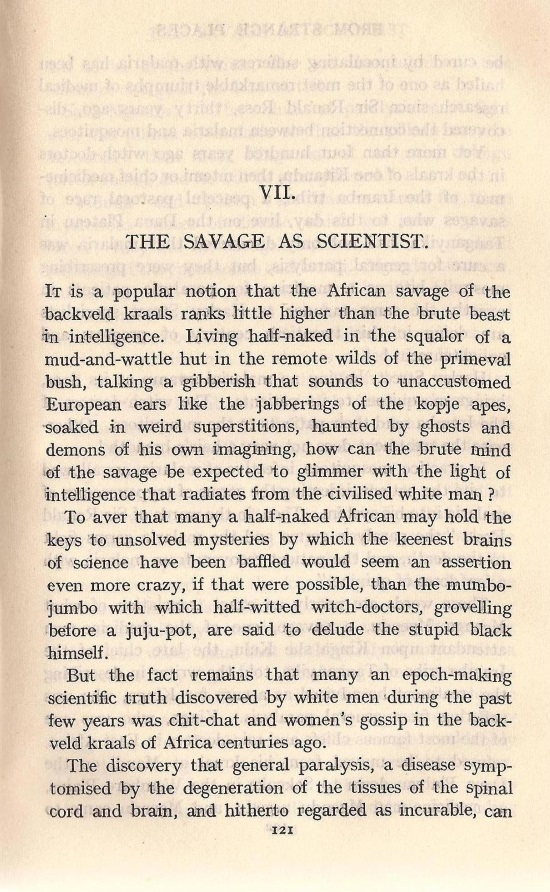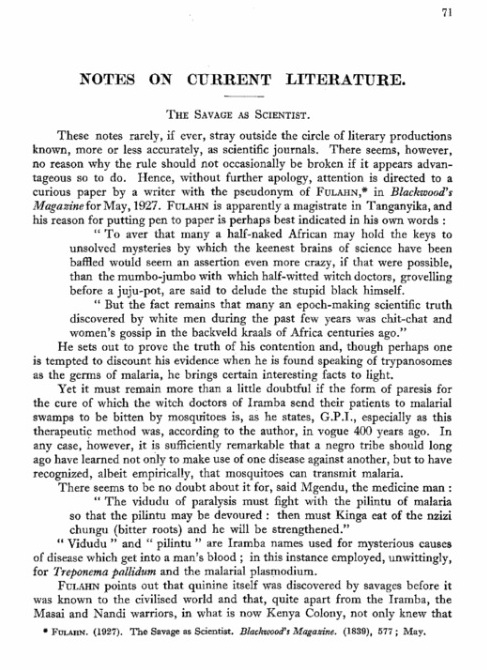Savage Scientists
Well, fight fire with fire, that sounds a wizard wheeze, what brilliant boffin thought that up? The official answer is that it was an ingenious (though unlovely) Austrian medical researcher with the slightly improbable surname of Wagner-Jauregg, who was in fact awarded the Nobel Prize for Medicine in 1927 for "his discovery of the therapeutic value of malaria inoculation in the treatment of dementia paralytica" [ie GPI]
As outlined below, he had hit on the idea some 10 years earlier, but of course Nobel Prizes always lag behind the curve.
Manson's Tropical Diseases, Elsevier, 23rd ed, 2009, p 533
43. Malaria p 532
Nicholas J White
....
....
In 1883 the Viennese psychiatrist Julius Wagner-Jauregg became interested in the relationship between fever and mental illness. Between 1888 and 1917 he experimented on a number of methods of inducing fever to treat patients with General Paralysis of the Insane (GPI is a form of neurosyphilis). On 14 Jun 1917 he inoculated blood from a soldier with tertian fever [a form of malaria causing fever every second day] into two patients with GPI. So began the era of malariatherapy of neurosyphilis. This became standard practice throughout the world until the introduction of penicillin 30 years later.
....
The technique became known as pyrotherapy 1, 2 as of course the elevated body-temperature caused by the malaria effectively burned-off the spirochetes which had been responsible for the syphilitic symptoms, and the malaria could then be exorcised by a few doses of quinine.
Another triumph for Western medical science, evidently.
Except that it possibly wasn't. In those politically-incorrect times, Europeans would have been mortified to think that African s*vag*s, a particularly uncompromising term for the indigenous people of the so-called Dark Continent, had been successfully using pyrotherapy for centuries before Wagner-Jaureg received his Nobel prize in 1927.
Indeed, that maybe these lamentably primitive n*t*ves had realised the relationship between malaria and mosquito-bites for further centuries before Ronald Ross received his Nobel prize for this in 1902 (having steamrollered the Nobel Committee into ignoring Giovanni Grassi, a much nicer man and probably the better scientist).
A very readable account of how the tribal elders or witch-doctors, uneducated by Western standards but steeped in the traditional oral wisdom accumulated by the observations and practices of uncounted ancestral generations, could possibly be so far ahead of technologically-driven European science, is given in
- 'Blackwood' Tales from the Outposts, Vol XI From Strange Places, Article VII The Savage as Scientist, by 'Fulahn' [Capt William Hichens]; publ William Blackwood and Sons, Edinburgh & London, 1933.
itself a reprint of the original publication six years earlier:
- 'Fulahn', The Savage as Scientist; Blackwood's Magazine, May 1927 p 577
Capt William Hichens was an officer in the Intelligence and Administrative Services of East Africa, who had a particular interest in crypto-zoology. Does that undermine his credibility? Well, the veracity of his account of these traditional tribal remedies could have been checked pretty easily during the days of British domination over Africa, but it wouldn't be nearly so easy now, for several obvious reasons.
He also makes one or two technical slips, which don't however undermine his central thesis:
- Trypanosomes cause sleeping-sickness rather than malaria, and are spread by the tsetse fly. Malaria is actually caused by plasmodia (which are indeed spread by the mosquito).
- It's unlikely that GPI was a problem in African communities four centuries prior to his article; syphilis was admittedly brought back from the Americas by European explorers at that time, but sexual contact between Europeans and sub-Saharan Africans was (I'd have thought) extremely unlikely until much later on. (But of course pyrotherapy isn't restricted to the treatment of GPI in any case.)
Of course there's always a sneaking suspicion that reminiscences of this sort, especially when well-peppered with snatches of Swahili, are the sort of thing so well parodied by Beachcomber's Big White Carstairs, Wodehouse's Captain Cuthbert Brabazon-Biggar, and so on. The Swahili seems to stand up when googled, so Hichens talked the talk – but did he also walk the walk, as an American colleague used to say?
Indeed, the second half of his article deals with his encounters with the occult aspects of witch-doctoring and ritual magic, much less credible in his eyes, and even less so to ours – and entirely unrelated to pyrotherapy! So for the moment at least, I've omitted it (especially as my scanner's playing up).
In fact a detailed technical critique of his article was published the following year
- Transactions of the Royal Society of Tropical Medicine and Hygiene
Volume 21, Issue 1, 11 July 1927, Pages 71–74
but I don't have access to more than the opening page, unfortunately.
So, ipso facto, I just don't know for sure what the current consensus may be, about Capt Hichens' article. But there doesn't appear to be any acknowledgement on the internet of African priority, so perhaps they got the thumbs-down in this review. But on what grounds – was a more persuasive counter-narrative produced, or did it just say (as every generation says about its predecessors, given half a chance) that these people didn't have the right mindset to come up with such radical ideas?



